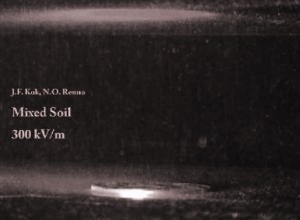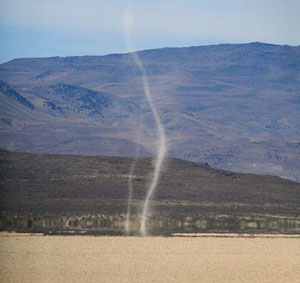Improved climate models could result from a better understanding of how erosion occurs as US researchers discover that electricity as well as wind is involved. The research may also have implications for planetary explorers.
Nilton Renno and Jasper Kok of the University of Michigan have developed a new model for how electricity generated by friction between airborne dust particles could affect erosion processes. Their findings suggest a new approach to understanding one of the biggest concerns in climate change, saltation and desertification and could displace the decades-old classical theory of erosion.

Nilton Renno
Saltation is the rather poorly understood process of wind blowing grains of sand across a landscape, sending them bouncing against the ground and each other. The bouncing motion of the saltating grains on the soil bed kicks dust aerosols into the air. However, the process has implications for climate change as the formation of suspended dust aerosols and atmospheric aerosols produced by burning fossil fuels are thought to affect the Earth’s climate by blocking and absorbing sunlight and leading to cloud formation.
Renno first noticed that electricity might be missing from the equation while studying dust devils in Arizona. The devils, it turned out, have a strong electric field. Renno and Kok have now discovered that saltation produces static electricity as particles rub against each other and their surroundings. It is a similar process to the production of static electricity in clouds of powdered products such as flour and custard that can represent an explosion hazard in food production. The static electric fields produced by bouncing sand dust particles are much stronger, however, and stronger still than previous research would have suggested.

A sample of desert soil in a metal container. The container is sitting on the lower of two metal plates between which an electric field is created. (Credit: Courtesy of University of Michigan)
Writing in the 11th of January issue of the journal Physical Review Letters, the researchers say, The effect of aerosols is one of the most uncertain processes in climate change modelling. We now know more of the physics of how dust aerosols get into the atmosphere, so we should be able to improve on the way that climate models account for their emission.

Are dust devils electric? (Credit: jurveston: http://www.flickr.com/photos/jurvetson/)
Other researchers have hinted that electricity may be involved in saltation, but Renno and Kok are the first to determine the extent to which it plays a part in the process. What we discovered is as these particles bounce and rub against each other, the surface of the ground gets a positive charge and the particles get a negative charge, Renno explains, The electric field can become strong enough to directly lift sand from the surface.
This is a fundamental change in our understanding of the physics of saltation that may also have extraterrestrial implications. Renno, who is a co-investigator on NASA’s Phoenix and Mars Science Laboratory missions to Mars, has speculated that these saltation electric fields get so large on the Red Planet that they could produce ground-level sparks. High-voltage Martian dust devils could be a serious hazard for planetary explorers Renno suggests
Further reading
Phys Rev Lett, 2008, in press;
http://arxiv.org/abs/0711.1341
Nilton Renno homepage
http://aoss.engin.umich.edu/people/nrenno
Suggested searches
erosion
desertification